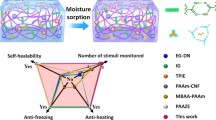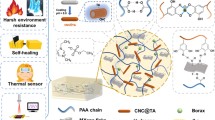Abstract
Electronic skins (E-skins) can detect human health and movement, and have potential in the fields of human–machine interactions and artificial intelligence. However, traditional hydrogel-based E-skins suffer from poor mechanical strength, low conductivity, and instability due to water evaporation. Herein, a semi-interpenetrating network developed by polysaccharide biomass konjac glucomannan (KGM) was introduced into a covalent-crosslinked network polyacrylamide-co- polyacrylic acid (PAM-co-PAA) to advance the above dissatisfaction of E-skins. This synthesized a transparent, tough, non-volatile, and highly stretchable ionogel with an ionic liquid named 1-ethyl-3-methylimidazolium dicyamide (EMIM:DCA) as conductive media. This ionogel exhibited extraordinary mechanical strength (tensile strength of 2.77 MPa), outstanding mechanical durability (100 stretching cycles of 250%), and elongation (elongation at break of 997%). More importantly, the ionogel demonstrated remarkable anti-freezing performance (high flexibility at -20℃) and high conductivity (3.94 mS/cm) in the absence of water. Besides, after assembling KGM-enhanced ionogel, the sensor exhibited comprehensive strain sensing performance, which could effectively and accurately monitor human motion via Bluetooth transmission. This strategy paves the way for a viable new generation of multifunctional biomimetic super-sensitive sensors, which are promising for applications such as intelligent devices, health detection, and biomedical monitoring in harsh conditions.
Graphical abstract









Similar content being viewed by others
Data availability
The Data used in this study are available from corresponding authors on reasonable request.
References
Ahmed S, Bui MPN, Abbas A (2016) Paper-based chemical and biological sensors: engineering aspects. Biosens Bioelectron 77:249–263. https://doi.org/10.1016/j.bios.2015.09.038
Cao Y, Huang G, Li X, Guo L, Xiao J (2022) Complex coacervation of carboxymethyl konjac glucomannan and ovalbumin and coacervate characterization. J Dispersion Sci Technol 43:1991–2001. https://doi.org/10.1080/01932691.2021.1888747
Chen L, Chang X, Chen J, Zhu Y (2022) Ultrastretchable, antifreezing, and high-performance strain sensor based on a muscle-inspired anisotropic conductive hydrogel for human motion monitoring and wireless transmission. Appl Mater Interfaces 14:43833–43843. https://doi.org/10.1021/acsami.2c14120
Chen Z, Chen Y, Hedenqvist MS, Chen C, Cai C, Li H, Liu H, Fu J (2021) Multifunctional conductive hydrogels and their applications as smart wearable devices. J Mater Chem B 9:2561–2583. https://doi.org/10.1039/d0tb02929g
Gao Y, Hu Y, Wang J, Ahmad H, Zhu J (2023) Modification of low-salt myofibrillar protein using combined ultrasound pre-treatment and konjac glucomannan for improving gelling properties: intermolecular interaction and filling effect. Int J Biol Macromol 250:126195. https://doi.org/10.1016/j.ijbiomac.2023.126195
Gao Y, Zhang Y, Feng C, Chu H, Feng C, Wang H, Wu L, Yin S, Liu C, Chen H, Li Z, Zou Z, Tang L (2022) A chromosome-level genome assembly of Amorphophallus konjac provides insights into konjac glucomannan biosynthesis. Comput Struct Biotechnol J 20:1002–1011. https://doi.org/10.1016/j.csbj.2022.02.009
Hajiali F, Jin T, Yang G, Santos M, Lam E, Moores A (2022) Mechanochemical transformations of biomass into functional materials. Chem Sustain Energy Mater 15:e202102535. https://doi.org/10.1002/cssc.202102535
Hou C, Xu Z, Qiu W, Wu R, Wang Y, Xu Q, Liu X, Guo W (2019) A biodegradable and stretchable protein-based sensor as artificial electronic skin for human motion detection. Small 15:1805084. https://doi.org/10.1002/smll.201805084
Hu Y, Tian J, Zou J, Zou J, Yuan X, Li J, Liang H, Zhan F, Li B (2019) Partial removal of acetyl groups in konjac glucomannan significantly improved the rheological properties and texture of konjac glucomannan and κ-carrageenan blends. Int J Biol Macromol 123:1165–1171. https://doi.org/10.1016/j.ijbiomac.2018.10.190
Huang Y, Zhao X, Ke J, Zha X, Yang J, Yang W (2023) Engineering nanoscale solid networks of ionogel for enhanced thermoelectric power output and excellent mechanical properties. Chem Eng J 456:141156. https://doi.org/10.1016/j.cej.2022.141156
Jiang N, Chang X, Hu D, Chen L, Wang Y, Chen J, Zhu Y (2021) Flexible, transparent, and antibacterial ionogels toward highly sensitive strain and temperature sensors. Chem Eng J 424:130418. https://doi.org/10.1016/j.cej.2021.130418
Kabanda MM, Bahadur I (2023) Preferred intermolecular cation···anion interactions within the [EMIM][DCA] ionic liquid and its interaction with a water co-solvent molecule. J Mol Liq 381:121804. https://doi.org/10.1016/j.molliq.2023.121804
Kalambate PK, Rao Z, Dhanjai WuJ, Shen Y, Boddula R, Huang Y (2020) Electrochemical (bio) sensors go green. Biosens Bioelectron 163:112270. https://doi.org/10.1016/j.bios.2020.112270
Kim J, Choi H, Rye H, Yoon K, Lee D (2020) A Study on the red clay binder stabilized with a polymer aqueous solution. Polymers 13:54. https://doi.org/10.3390/polym13010054
Kim J, Kim J-W, Keum K, Lee H, Jung G, Mihyeon P, Lee Y, Kim S, Ha J (2023) A multi-responsive self-healing and air-stable ionogel for a vertically integrated device comprised of flexible supercapacitor and strain sensor. Chem Eng J 457:141278. https://doi.org/10.1016/j.cej.2023.141278
Klepić M, Setničková K, Lanč M, Zák M, Izák P, Dendisová M, Fuoco A, Jansen JC, Friess K (2020) Permeation and sorption properties of CO2 -selective blend membranes based on polyvinyl alcohol (PVA) and 1-ethyl-3-methylimidazolium dicyanamide ([EMIM][DCA]) ionic liquid for effective CO2 /H2 separation. J Membr Sci 597:117623. https://doi.org/10.1016/j.memsci.2019.117623
Li W, Fan Q, Chai C, Chu Y, Hao J (2023) Ti3C2-MXene ionogel with long-term stability and high sensitivity for wearable piezoresistive sensors. Colloids Surf, A 665:131202. https://doi.org/10.1016/j.colsurfa.2023.131202
Liao M, Wan P, Wen J, Gong M, Wu X, Wang Y, Shi R, Zhang L (2017) Wearable, healable, and adhesive epidermal sensors assembled from mussel-inspired conductive hybrid hydrogel framework. Adv Func Mater 27:1703852. https://doi.org/10.1002/adfm.201703852
Lipomi DJ, Vosgueritchian M, Tee BCK, Hellstrom SL, Lee JA, Fox CH, Bao Z (2011) Skin-like pressure and strain sensors based on transparent elastic films of carbon nanotubes. Nat Nanotechnol 6:788–792. https://doi.org/10.1038/nnano.2011.184
Pang Y, Zhang K, Yang Z, Jiang S, Ju Z, Li Y, Wang X, Wang D, Jian M, Zhang Y, Liang R, Tian H, Yang Y, Ren T (2018) Epidermis microstructure inspired graphene pressure sensor with random distributed spinosum for high sensitivity and large linearity. ACS Nano 12:2346–2354. https://doi.org/10.1021/acsnano.7b07613
Rezaei FS, Sharifianjazi F, Esmaeilkhanian A, Salehi E (2021) Chitosan films and scaffolds for regenerative medicine applications: a review. Carbohyd Polym 273:118631. https://doi.org/10.1016/j.carbpol.2021.118631
Seabra AB, Bernardes JS, Fávaro WJ, Paula AJ, Durán N (2018) Cellulose nanocrystals as carriers in medicine and their toxicities: a review. Carbohyd Polym 181:514–527. https://doi.org/10.1016/j.carbpol.2017.12.014
Song H, Yu X, Nguyen D, Zhang C, Liu T (2022) Highly stretchable, self-healable and self-adhesive polyzwitterion ionogels enabled with binary noncovalent interactions. Compos Commun 34:101251. https://doi.org/10.1016/j.coco.2022.101251
Strauss K, Chmielewski J (2016) Advances in the design and higher-order assembly of collagen mimetic peptides for regenerative medicine. Curr Opin Biotechnol 46:34–41. https://doi.org/10.1016/j.copbio.2016.10.013
Sun L, Chen S, Guo Y, Song J, Zhang L, Xiao L, Guan Q, You Z (2019) Ionogel-based, highly stretchable, transparent, durable triboelectric nanogenerators for energy harvesting and motion sensing over a wide temperature range. Nano Energy 63:103847. https://doi.org/10.1016/j.nanoen.2019.06.043
Sun Y, Wang S, Du X, Du Z, Wang H, Cheng X (2021) Skin-conformal MXene-doped wearable sensors with self-adhesive, dual-mode sensing, and high sensitivity for human motions and wireless monitoring. J Mater Chem B 9:8667–8675. https://doi.org/10.1039/d1tb01769a
Tie F, Mao Z, Zhang L, Zhong Y, Sui X, Xu H (2022) Conductive ionogel with underwater adhesion and stability as multimodal sensor for contactless signal propagation and wearable devices. Compos B Eng 232:109612. https://doi.org/10.1016/j.compositesb.2022.109612
Wang H, Li X, Ji Y, Xu J, Ye Z, Wang S, Du X (2022a) Highly transparent, mechanical, and self-adhesive zwitterionic conductive hydrogels with polyurethane as a cross-linker for wireless strain sensors. J Mater Chem B 10:2933–2943. https://doi.org/10.1039/d2tb00157h
Wang H, Xiang J, Wen X, Du X, Wang Y, Du Z, Cheng X, Wang S (2022b) Multifunctional skin-inspired resilient MXene-embedded nanocomposite hydrogels for wireless wearable electronics. Compos A Appl Sci Manuf 155:106835. https://doi.org/10.1016/j.compositesa.2022.106835
Wang H, Xu J, Li K, Dong Y, Du Z, Wang S (2022c) Highly stretchable, self-healable, and self-adhesive ionogels with efficient antibacterial performances for a highly sensitive wearable strain sensor. J Mater Chem B 10:1301–1307. https://doi.org/10.1039/d2tb00041e
Wang S, Xiang J, Sun Y, Wang H, Du X, Cheng X, Du Z, Wang H (2021) Skin-inspired nanofibrillated cellulose-reinforced hydrogels with high mechanical strength, long-term antibacterial, and self-recovery ability for wearable strain/pressure sensors. Carbohyd Polym 261:117894. https://doi.org/10.1016/j.carbpol.2021.117894
Wu D, Yu S, Liang H, He C, Li J, Li B (2020) The influence of deacetylation degree of konjac glucomannan on rheological and gel properties of konjac glucomannan/κ-carrageenan mixed system. Food Hydrocoll 101:105523. https://doi.org/10.1016/j.foodhyd.2019.105523
Wu H, Wu H, Qing Y, Wu C, Pang J (2022a) KGM/chitosan bio-nanocomposite films reinforced with ZNPs: colloidal, physical, mechanical and structural attributes. Food Packag Shelf Life 33:100870. https://doi.org/10.1016/j.fpsl.2022.100870
Wu Y, Ren Y, Liang Y, Li Y (2022b) Semi-IPN ionogel based on poly (ionic liquids)/xanthan gum for highly sensitive pressure sensor. Int J Biol Macromol 223:327–334. https://doi.org/10.1016/j.ijbiomac.2022.10.263
Xiang S, He X, Zheng F, Lu Q (2022) Multifunctional flexible sensors based on ionogel composed entirely of ionic liquid with long alkyl chains for enhancing mechanical properties. Chem Eng J 439:135644. https://doi.org/10.1016/j.cej.2022.135644
Xie F, Gao X, Yu Y, Lu F, Zheng L (2021) Dually cross-linked single network poly(ionic liquid)/ionic liquid ionogels for a flexible strain-humidity bimodal sensor. Soft Matter 17:10918–10925. https://doi.org/10.1039/d1sm01453f
Xu J, Wang H, Du X, Cheng X, Du Z, Wang H (2021) Self-healing, anti-freezing and highly stretchable polyurethane ionogel as ionic skin for wireless strain sensing. Chem Eng J 426:130724. https://doi.org/10.1016/j.cej.2021.130724
Xu J, Wang H, Wen X, Wang S, Wang H (2022) Mechanically strong, wet adhesive, and self-healing polyurethane ionogel enhanced with a semi-interpenetrating network for underwater motion detection. ACS Appl Mater Interfaces 14:54203–54214. https://doi.org/10.1021/acsami.2c15058
Xue R, Zhou N, Yin S, Qian Z, Dai Z, Xiong Y (2023) All-polymer dynamical ionogel-like materials with benzyl-mediated ultra-strong adhesion for flexible sensor application. Chem Eng J 465:143072. https://doi.org/10.1016/j.cej.2023.143072
Zhang K, Ge F, Tang F, Tan L, Qiu Y, Zhu X (2023) A structure-property study for konjac glucomannan and guar galactomannan: Selective carboxylation and scale inhibition. Carbohyd Polym 299:120220. https://doi.org/10.1016/j.carbpol.2022.120220
Zhou J, Zhuo F, Long X, Liu Y, Lu H, Lou J, Chen L, Dong S, Fu Y, Duang H (2022) Bio-inspired, super-stretchable and self-adhesive hybrid hydrogel with SC-PDA/GO-Ca2+/PAM framework for high precision wearable sensors. Chem Eng J 447:137259. https://doi.org/10.1016/j.cej.2022.137259
Zhou Q, Wang Y, Zhu T, Lian M, Nguyen D, Zhang C (2023) Highly stretchable, self-healable and wide temperature-tolerant deep eutectic solvent-based composite ionogels for skin-inspired strain sensors. Compos Commun 41:101658. https://doi.org/10.1016/j.coco.2023.101658
Zhu A, Huang J, Xie H, Yue W, Qin S, Zhang F, Xu Q (2022) Use of a superbase/DMSO/CO2 solvent in order to incorporate cellulose into organic ionogel electrolyte for flexible supercapacitors. Chem Eng J 446:137032. https://doi.org/10.1016/j.cej.2022.137032
Zhu F (2018) Modifications of konjac glucomannan for diverse applications. Food Chem 256:419–426. https://doi.org/10.1016/j.foodchem.2018.02.151
Zhu M, Jin H, Shao T, Li Y, Liu J, Gan L, Long M (2020) Polysaccharide-based fast self-healing ion gel based on acylhydrazone and metal coordination bonds. Mater Des 192:108723. https://doi.org/10.1016/j.matdes.2020.108723
Acknowledgements
I would like to express my gratitude to the College of Biomass Science and Engineering, Sichuan University, my supervisor and my senior apprentices in the research group.
Funding
This work was funded by Support Plan of Science and Technology Department of Sichuan Province, China (NO. 2022YFG0273, 2023YFS0168, 2023NSFSC0308, 2023YFS0460), Sichuan University “0 to one” innovation research project (NO. 2022SCUH0024), Sichuan University Postdoctoral Interdisciplinary Innovation Fund (NO. JCXK2229), Fundamental Research Funds for the Central Universities (NO. 2023SCU12107). The authors would appreciate Hui Wang from Pub-Lab Platform, West China School of Basic Medical Sciences and Forensic Medicine, Sichuan University for assistance with the testing process.
Author information
Authors and Affiliations
Contributions
Zhifan Ye: Conceptualization, Methodology, Visualization, Investigation, Writing-original draft. Min Yang: Modification. Yijia Zheng: Visualization, Methodology, Data curation. Qihan Jia: Validation, Investigation. Haibo Wang: Resources. Junjie Xiong: Investigation. Shuang Wang: Investigation, Visualization, Methodology.
Corresponding authors
Ethics declarations
Consent for publication
All authors revised the manuscript and agreed with the publication.
Competing interests
The authors declare no competing interests.
Additional information
Publisher's Note
Springer Nature remains neutral with regard to jurisdictional claims in published maps and institutional affiliations.
Rights and permissions
Springer Nature or its licensor (e.g. a society or other partner) holds exclusive rights to this article under a publishing agreement with the author(s) or other rightsholder(s); author self-archiving of the accepted manuscript version of this article is solely governed by the terms of such publishing agreement and applicable law.
About this article
Cite this article
Ye, Z., Yang, M., Zheng, Y. et al. Transparent, mechanically robust, low-temperature-tolerant, and stretchable ionogels enhanced by konjac glucomannan toward wireless strain sensors. Cellulose (2024). https://doi.org/10.1007/s10570-024-05899-5
Received:
Accepted:
Published:
DOI: https://doi.org/10.1007/s10570-024-05899-5




